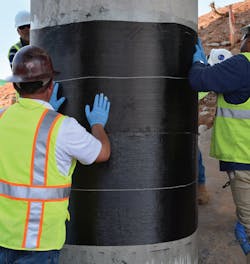The fundamentals for fiber-reinforced polymer (FRP) strengthening
United States infrastructure is aging. In its 2017 Infrastructure Report Card, the American Society of Civil Engineers (ASCE) issued a grade of C+ for the condition of the country’s bridges. Of the 614,387 bridges in the country, almost 40% are 50 years or older and about 10% are posted with a load restriction. So, what is the U.S. doing about this issue? As much as it can afford, but right now that is not much—the nation’s backlog of bridge rehabilitation needs is estimated at $123 billion. ASCE reported that most bridges were designed for a lifespan of 50 years, so an increasing number will soon need major rehabilitation. Additionally, some studies indicate that the indirect costs of deteriorating infrastructure, when factoring in traffic delays and loss in productivity, could be as high as 10 times the cost to fix the structural damage.
Why Fiber-Reinforced Polymer (FRP)?
Extending the life of a structurally deficient bridge through rehabilitation is almost always preferred over replacement. Compared to traditional repair methods using steel or concrete, fiber-reinforced polymer (FRP) materials are an ideal alternative. They are lightweight, corrosion resistant and have superior mechanical properties. FRPs compete with many strengthening techniques but are often the most attractive solution; though the actual materials are more expensive than the traditional options, the total construction cost is often cheaper.
Click below to download this white paper.
